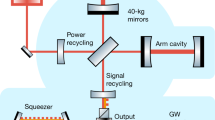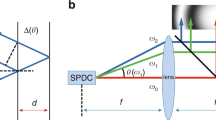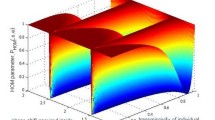Abstract
A simple geometry utilizing a laser-excited atomic beam as light source, and a nearby oscillating mirror, would permit the observation of a two-channel optical interference effect involving photons which can be localized predominantly in one channel by coincidence observations of the recoiling source atom. A sacrifice of the optimum conditions for photon interference is necessary even when photon localization in one channel is accomplished by an observation of the recoil atom. This necessity arises because the width of the slit defining the atomic beam, and with it the important optical source dimension, must be comparable to the optical wavelength to obtain the small uncertainty in initial total momentum needed for significant localization. Quantum mechanical calculations of the coincidence intensity and singles intensity as a function of mirror position are made for a source width of five quarter wavelengths and are compared to a classical optics calculation of the singles intensity. The coincidence intensity calculation, as expected, predicts a smaller interference effect than classical optics due to the photon localization. The singles intensity calculation also predicts the same reduction in the classical interference effect, as a consequence of the orthoganality of the final atom states.
Similar content being viewed by others
References
J. von Neumann,Mathematical Foundations of Quantum Mechanics (Princeton University Press, Princeton, 1955), Chap. VI, Sec. 2.
J. M. Jauch,Foundations of Quantum Mechanics (Addison Wesley, Reading, Massachusetts, 1968), Chap. 11, Sec. 8.
A. Kantrowitz and J. Grey,Rev. Sci. Instrum. 22, 328 (1950).
D. W. Fahey, W. F. Parks, and L. D. Schearer,J. Phys. E 13, 381 (1980).
R. P. Feynman,Quantum Mechanics and Path Integrals (McGraw-Hill, New York, 1965).
A. Garuccio, K. R. Popper, and J.-P. Vigier,Phys. Lett. A 86, 397 (1981).
L. Mandel,Phys. Lett. A 89, 325 (1982).
H. Morowitz,Phys. Rev. 187, 1972 (1969).
H. Kuhn,J. Chem. Phys. 53, 101 (1969).
J. F. Clauser, M. A. Horne, A. Shimony, and R. A. Holt,Phys. Rev. Lett. 23, 880 (1969).
R. Friedberg, 1969, unpublished.
N. D. Mermin,Am. J. Phys. 49, 940 (1981).
Author information
Authors and Affiliations
Rights and permissions
About this article
Cite this article
Engelke, C.E., Engelke, C.W. The effect of localization on interference. I. Calculated intensities for a feasible optical experiment. Found Phys 16, 905–916 (1986). https://doi.org/10.1007/BF00765337
Received:
Revised:
Issue Date:
DOI: https://doi.org/10.1007/BF00765337




